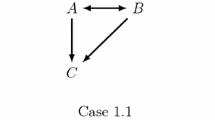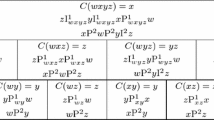Abstract
When encountering a set of alternatives displayed in the form of a list, the decision maker usually determines a particular alternative, after which she stops checking the remaining ones, and chooses an alternative from those observed so far. We present a framework in which both decision problems are explicitly modeled, and axiomatically characterize a ‘divide-and-choose’ rule which unifies successive choice and satisficing choice.
Similar content being viewed by others
Notes
See Bearden and Connolly (2008) for an analysis of the dilemmas a decision maker faces when setting her aspiration levels.
In particular, an agent observes the decision-making procedure of the other agents and then takes her own decision.
Other ways for deriving an endogenous stopping policy are also possible. See for instance the game theoretic analysis in Tang et al. (2009), where a shortest acceptable deadline determines the partitioning of the responder’s strategy space.
For a discussion on these two effects in marketing we refer the reader to Murphy et al. (2006) and the works cited therein.
References
Apesteguia, J., & Ballester, M. A. (2013). Choice by sequential procedures. Games and Economic Behavior, 77, 90–99.
Bearden, J. N., & Connolly, T. (2008). On optimal satisficing: How simple policies can achieve excellent results. In T. Kugler, J. C. Smith, T. Connolly, & Y.-J. Son (Eds.), Decision modeling and behavior in complex and uncertain environments (pp. 79–97). New York: Springer.
Caplin, A., & Dean, M. (2011). Search, choice, and revealed preference. Theoretical Economics, 6, 19–48.
Caplin, A., Dean, M., & Martin, D. (2011). Search and satisficing. American Economic Review, 101, 2899–2922.
Diehl, K., & Zauberman, G. (2005). Searching ordered sets: evaluations from sequences under search. Journal of Consumer Research, 31, 824–832.
Eliaz, K., & Rubinstein, A. (2014). A model of observational learning with boundedly rational “neuro” agents. Economic Theory, 57, 515–528.
Guney, B. (2014). A theory of iterative search in lists. Journal of Mathematical Economics, 53, 26–32.
Horan, S. (2010). Sequential search and choice from lists, Working Paper.
Knoepfle, D., Wang, J., & Camerer, C. (2009). Studying learning in games using eyetracking. Journal of the European Economic Association, 7, 388–398.
Lim, Ch., Bearden, J. N., & Smith, J. C. (2006). Sequential search with multiattribute options. Decision Analysis, 3(1), 3–15.
Mandler, M., Manzini, P., & Mariotti, M. (2012). A million answers to twenty questions: choosing by checklist. Journal of Economic Theory, 147, 71–92.
Masatlioglu, Y., & Nakajima, D. (2013). Choice by iterative search. Theoretical Economics, 8, 701–728.
Murphy, Y., Hofacker, C., & Mizerski, R. (2006). Primacy and recency effects on clicking behavior. Journal of Computer-Mediated Communication, 11, 522–535.
Papi, M. (2012). Satisficing choice procedures. Journal of Economic Behavior and Organization, 84, 451–462.
Plott, C. (1973). Path independence, rationality, and social choice. Econometrica, 41, 1075–1091.
Rubinstein, A., & Salant, Y. (2006). A model of choice from lists. Theoretical Economics, 1, 3–17.
Salant, Y. (2003). Limited computational resources favor rationality, Discussion Paper 320, Center for the Study of Rationality, Hebrew University of Jerusalem.
Salant, Y. (2011). Procedural analysis of choice rules with applications to bounded rationality. American Economic Review, 101, 724–748.
Salant, Y., & Rubinstein, A. (2008). (A, f): Choice with frames. Review of Economic Studies, 75, 1287–1296.
Shi, S., Wedel, M., & Pieters, F. (2013). Information acquisition during online decision making: A model-based exploration using eye-tracking data. Management Science, 59, 1009–1026.
Simon, H. A. (1955). A behavioral model of rational choice. Quarterly Journal of Economics, 69, 99–118.
Smith, J. C., Lim, C., & Bearden, J. N. (2007). On the multi-attribute stopping problem with general value functions. Operations Research Letters, 35, 324–330.
Stüttgen, P., Boatwright, P., & Monroe, R. (2012). A satisficing choice model. Marketing Science, 31, 878–899.
Tang, W., Bearden, J. N., & Tsetlin, I. (2009). Ultimatum deadlines. Management Science, 55(8), 1423–1437.
Tyson, C. (2008). Cognitive constraints, contraction consistency, and the satisficing criterion. Journal of Economic Theory, 138(1), 51–70.
Wang, J., Spezio, M., & Camerer, C. (2010). Pinocchio’s pupil: Using eyetracking and pupil dilation to understand truth telling and deception in sender–receiver games. American Economic Review, 100, 984–1007.
Weitzman, M. L. (1979). Optimal search for the best alternative. Econometrica, 47, 641–654.
Yildiz, K. (2015). List rationalizable choice, Theoretical Economics, forthcoming.
Acknowledgments
We would like to thank the associate editor and two anonymous referees as well as Salvador Barberà, Walter Bossert, Dipjyoti Majumdar, Paola Manzini, Marco Mariotti, Jordi Massó, Debasis Mishra, Ariel Rubinstein, and Arunava Sen for their very helpful comments. Nozomu Muto and Saptarshi Mukherjee gratefully acknowledge financial support from JSPS Grants-in-Aid for Scientific Research No. 26780116 and from FEDER and the Spanish Ministry of Science and Innovation through grant “Consolidated Group-C” ECO2008-04756, respectively.
Author information
Authors and Affiliations
Corresponding author
Appendix 1
Appendix 1
In order to show the independence of the above five axioms, let us consider the following examples of sc-rules each of which satisfies four of the axioms but violates the fifth one.
Example 3
Fix \(x^{*}\in X\) and define \(C^{1}\) as follows: for all \(\ell \in \Lambda \), \(C^{1}\left( \ell \right) =\left\langle \ell _{k},k\right\rangle \) if \(\ell _{k}=x^{*}\) and \(k\in \left\{ 1,le(\ell )\right\} \); \(C^{1}\left( \ell \right) =\left\langle \ell _{k-1},k-1\right\rangle \) if \(\ell _{k}=x^{*}\) and \(k\in \left\{ 2,\ldots ,le(\ell )-1\right\} \); and \(C^{1}\left( \ell \right) =\left\langle \ell _{1},le(\ell )\right\rangle \), otherwise. This sc-rule violates axiom 1 as for \(a,b,c,x^{*}\in X\), \(C(a,b,x^{*},c)=\left\langle b,2\right\rangle \) but \(C(a,b,c)=\left\langle a,3\right\rangle \). On the other hand, \(C^{1}\) satisfies axiom 2: the decision maker continues his search till the end of any list which either does not contain \(x^{*}\) or \(x^{*}\) is the last option in the list; otherwise, the premise in axiom 2 is not satisfied. Clearly, \(C^{1}\) fulfills our third requirement since the decision maker always stops either before \(x^{*}\) or immediately after \(x^{*}\) and selects it (of course, when \(x^{*}\) is present in the list). The proposed rule also satisfies axiom 4 since \(C^{1}\left( \ell \right) =\left\langle x,le(\ell )\right\rangle \) with \(x=\ell _{q}\) and \( q<le(\ell )\) can happen only if \(x^{*}\notin X(\ell )\). We have in this case that \(C^{1}(x,y)=\left\langle x,2\right\rangle \) follows for any \(y\in \left\{ \ell _{q+1},\ldots ,\ell _{le(\ell )}\right\} \) as required by axiom 4. Finally, in order to see that \(C^{1}\) satisfies axiom 5 as well, notice that \(C^{1}(x,y)=\left\langle x,2\right\rangle \) and \(C^{1}(\ell )=\left\langle x,le(\ell )\right\rangle \) imply \(x^{*}\notin X(\ell )\cup \left\{ y\right\} \) and thus, \(x=\ell _{1}\). Thus, \(C^{1}(\ell ,y)=\left\langle x,le(\ell )+1\right\rangle \) follows.
Example 4
Let \(C^{2}\) be such that for all \(\ell \in \Lambda \), \( C^{2}\left( \ell \right) =\left\langle \ell _{le(\ell )},le(\ell )\right\rangle \) if \(le(\ell )\le 2\) and \(C^{2}\left( \ell \right) =\left\langle \ell _{2},2\right\rangle \), otherwise. Axiom 1 is satisfied by \(C^{2}\) as \(C^{2}\left( \ell \right) =\left\langle x,k\right\rangle \) with \( k<le(\ell )\) implies \(C^{2}\left( \ell \right) =\left\langle \ell _{2},2\right\rangle \) and thus, it holds for any \(\ell \in \Lambda \) with \( le(\ell )>2\). In order to see that \(C^{2}\) violates axiom 2 let us consider the options \(x,y,z\in X\) and note that we have the following outcomes: \( C^{2}(x,y)=\left\langle y,2\right\rangle \), \(C^{2}(y,z)=\left\langle z,2\right\rangle \), and \(C^{2}(x,y,z)=\left\langle y,2\right\rangle \). From \( C^{2}(x,y,z)=\left\langle y,2\right\rangle \) we have a clear violation of axiom 2 as this axiom requires the decision maker to stop after z in the list (x, y, z). The other three axioms are vacuously satisfied since they impose restrictions on a sc-rule C only if, for \(x,y\in X\), \( C(x,y)=\left\langle x,1\right\rangle \), \(C(x,y)=\left\langle x,2\right\rangle \), or \(C(\ell )=\left\langle x,le(\ell )\right\rangle \) with \(x\ne \ell _{le(\ell )}\). Notice that the proposed sc-rule \(C^{2}\) never induces such outcomes.
Example 5
Fix \(x^{*}\in X\) and define \(C^{3}\) as follows: for all \(\ell \in \Lambda \), \(C^{3}\left( \ell \right) =\left\langle \ell _{1},1\right\rangle \) if \(\ell _{1}=x^{*}\) and \(C^{3}(\ell )=\left\langle \ell _{le(\ell )},le(\ell )\right\rangle \), otherwise. This sc-rule violates axiom 3 as for instance for \(y,z\in X\), \(C^{3}(x^{*},y)=\left\langle x^{*},1\right\rangle \) but \(C^{3}(y,x^{*},z)=\left\langle z,3\right\rangle \), i.e., the decision maker has continued her search after \(x^{*}\) was displayed to her in the list \(\left( y,x^{*},z\right) \). Clearly, \(C^{3}\) satisfies axiom 1 as \(C^{3}\left( \ell \right) =\left\langle x,k\right\rangle \) with \(k<le(\ell )\) can happen only if \(\ell _{1}=x^{*}\) and thus, \(C^{3}\left( \ell \right) =\left\langle x^{*},1\right\rangle \) holds for any such list. This sc-rule also satisfies axiom 2: the decision maker continues her search till the end of any list not containing \(x^{*}\) at first place, while for all other lists we note that \(C^{3}(\ell )=\left\langle x,le(\ell )\right\rangle \) implies \(x=x^{*}=\ell _{1}=\ell _{le(\ell )}\) and thus, \(C^{3}(\ell _{le(\ell )},y)=C^{3}(x^{*},y)\ne \left\langle \ell _{le(\ell )},1\right\rangle =\left\langle x^{*},1\right\rangle \) can never happen due to the definition of \(C^{3}\). Finally, it is easy to see that \(C^{3}\) vacuously satisfies axioms 4 and 5, the reason being that a decision maker applying \(C^{3}\) never selects an option different from the last one, provided that she has encountered all alternatives in a list.
Example 6
Take the sc-rule \(C^{4}\) defined for all \(\ell \in \Lambda \) by \(C^{4}\left( \ell \right) =\left\langle \ell _{le(\ell )},le(\ell )\right\rangle \) if \(le(\ell )\le 2\) and \(C^{4}(\ell )=\left\langle \ell _{2},le(\ell )\right\rangle \), otherwise. Notice that for \(x,y,z\in X\) we have \(C^{4}(x,y,z)=\left\langle y,3\right\rangle \) and \( C^{4}(y,z)=\left\langle z,2\right\rangle \) in violation of axiom 4. Clearly, \(C^{4}\) satisfies axioms 1, 2 and 3, the reason being that the decision maker always stops at the end of a list (implying that axiom 1 is vacuously satisfied and as required by axiom 2) and that for \(x,y\in X\) the situation \( C^{4}(x,y)=\left\langle x,1\right\rangle \) never happens (and this is a premise in axiom 3). As \(C^{4}(x,y)=\left\langle x,2\right\rangle \) never happens either, axiom 5 is satisfied as well.
Example 7
Define \(C^{5}\) as follows: for all \(\ell \in \Lambda \), \( C^{5}(\ell )=\left\langle \ell _{1},le(\ell )\right\rangle \) if \(le(\ell )<3\) and \(C^{5}(\ell )=\left\langle \ell _{3},le(\ell )\right\rangle \), otherwise. This rule satisfies axioms 1 and 2 (the decision maker always stops at the end of a list), axiom 3 (as \(C^{4}(x,y)=\left\langle x,1\right\rangle \) never happens), and axiom 4 (since each of \( C^{5}(x,y)=\left\langle x,2\right\rangle \) for \(x,y\in X\), \(C^{5}(\ell _{1})=\left\langle \ell _{1},1\right\rangle \), and \(C^{5}(\ell _{1},\ell _{2},\ell _{3})=\left\langle \ell _{3},3\right\rangle \) clearly holds). Notice however that, for \(x,y,z\in X\), we have \(C^{5}(x,y)=\left\langle x,2\right\rangle =C^{5}(x,z)\) and \(C^{5}(x,y,z)=\left\langle z,3\right\rangle \) in violation of axiom 5.
Rights and permissions
About this article
Cite this article
Dimitrov, D., Mukherjee, S. & Muto, N. ‘Divide-and-choose’ in list-based decision problems. Theory Decis 81, 17–31 (2016). https://doi.org/10.1007/s11238-015-9522-z
Published:
Issue Date:
DOI: https://doi.org/10.1007/s11238-015-9522-z




